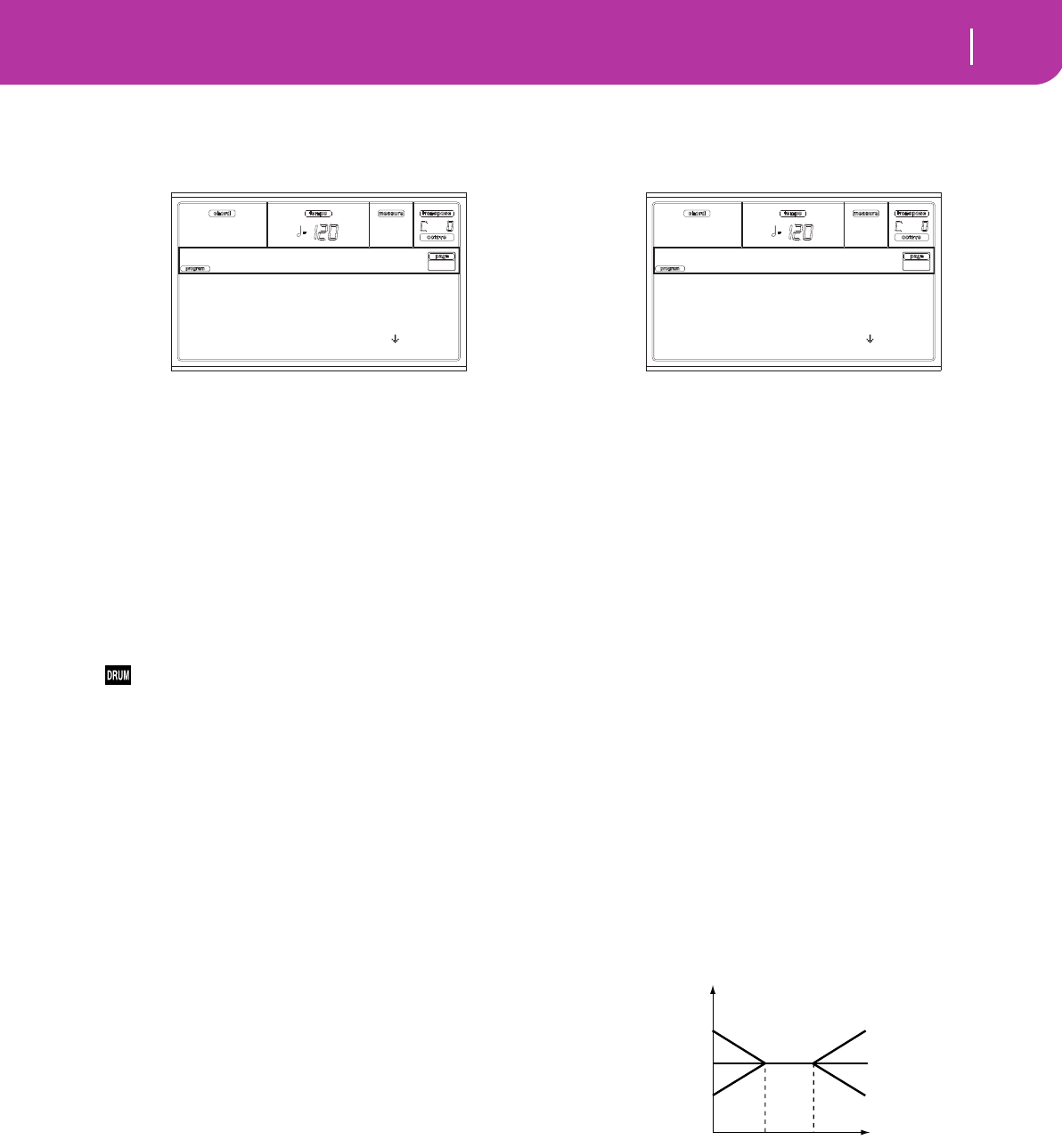
117
Program operating mode
Page 12 - Amp
PAGE 12 - AMP
These parameters control the volume and pan of the selected
oscillator.
Selected
Use this parameter to select an oscillator to put in edit. Alter-
natively, you can select oscillators using the F1-F4 buttons.
Level
Volume of the selected oscillator.
Note: The volume of a Program can be controlled by CC#7 (vol-
ume) and #11 (expression). The resulting level is determined by
multiplying the values of CC#7 and #11. The Global MIDI
channel is used for control.
0…127 Volume level.
Pan
Pan (stereo position) of the selected oscillator.
This parameter is not available when editing a Drum Pro-
gram. Use the individual Pan control for each key (see
“Pan” on page 109).
Random The sound will be heard from a different loca-
tion at each note-on.
L001 Places the sound at far left.
C064 Places the sound in the center.
R127 Places the sound to far right.
Note: This can be controlled by CC#10 (panpot). A CC#10
value of 0 or 1 will place the sound at the far left, a value of 64
will place the sound at the location specified by the “Pan” setting
for each oscillator, and a value of 127 will place the sound at the
far right. This is controlled on the global MIDI channel.
Pan modulation
AMS (Alternate Modulation Source)
Selects the source that will modify pan (see “AMS (Alternate
Modulation Source) list” on page 123). This change will be
relative to the “Pan” setting.
Intensity
Specifies the depth of the effect produced by “AMS”. For
example, if “Pan” is set to C064 and “AMS” is Note Number,
positive (+) values of this parameter will cause the sound to
move toward the right as the note numbers increase beyond
the C4 note (i.e., as you play higher), and toward the left as
the note numbers decrease (i.e., as you play lower). Negative
(–) values of this parameter will have the opposite effect.
-99…+99 Parameter value.
PAGE 13 - AMP MODULATION
These settings allow you to apply modulation to amp (for
each oscillator) to modulate the volume.
Selected
Use this parameter to select an oscillator to put in edit. Alter-
natively, you can select oscillators using the F1-F4 buttons.
Amplifier keyboard tracking
These parameters let you use keyboard tracking to adjust the
volume of the selected oscillator. Use the “Key” and “Ramp”
parameters to specify how the volume will be affected by the
keyboard location that you play.
Tracking Low/High
These settings specify the note number at which keyboard
tracking will begin to apply. The volume will not change
between “Tracking Low” and “Tracking High”.
C–1…G9 Lowest/Highest note in the range.
Tracking Low
Keyboard tracking will apply to the range below the specified
note number.
Tracking High
Keyboard tracking will apply to the range above the specified
note number.
Ramp
These parameters specify the angle of keyboard tracking.
-99…+99 Angle value.
Here is an example of volume changes produced by keyboard
location and “Ramp” settings:
Ramp Low
With positive (+) values of this parameter, the volume will
increase as you play notes below the “Tracking Low” note
number. With negative (–) values, the volume will decrease.
Ramp High
With positive (+) values of this parameter, the volume will
increase as you play notes above the “Key High” note number.
With negative (–) values, the volume will decrease.
Selected: Osc1
Level: 120
Pan: L001
AMS: Note Number
Amp |Osc1
Selected: Osc1
Tracking Low: C 3
Tracking High: A#4
Ramp Low: +48
Amp Mod |Osc1
Volume
Key
Ramp Low=+99
Ramp Low=0
Ramp Low=–99
Ramp High=+99
Ramp High=0
Ramp High=–99
Key Low
Key High
